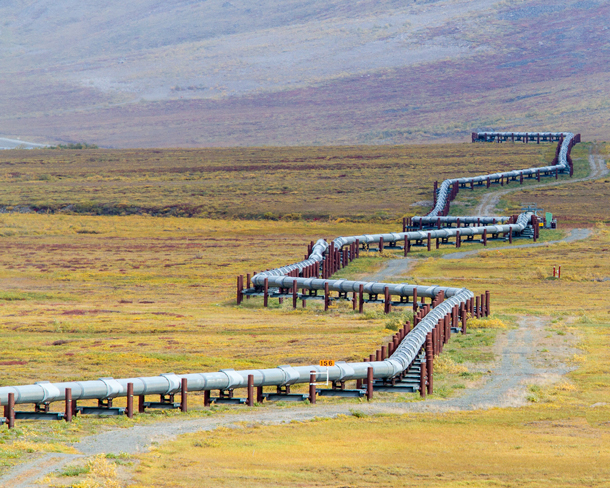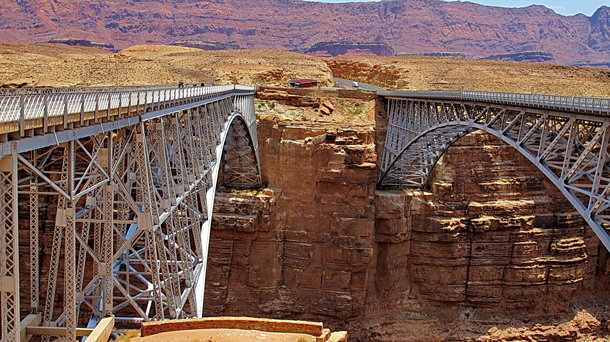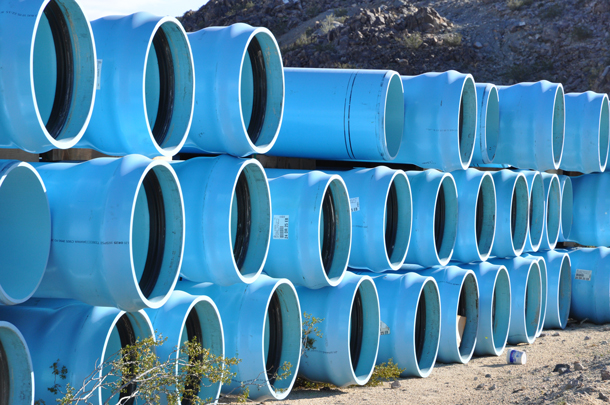Trump Moves to Weaken NEPA
Air Date: Week of January 17, 2020

The Trans-Alaska pipeline, with its 12 pumping stations and hundreds of miles of feeder pipelines, is an example of the kind of infrastructure project which requires NEPA review. (Photo by Arthur T. LaBar, Flickr, CC BY-NC 2.0)
The National Environmental Policy Act (NEPA), forms the bedrock of environmental protection at the federal level. It was signed into law 50 years ago by President Richard Nixon and requires environmental review before federal agencies begin substantial new infrastructure projects that could cause or increase environmental harm. Now the Trump Administration says it wants to streamline procedures under NEPA to make it easier for large federal projects to move forward, but critics say it will gut certain environmental protections. Michael Gerrard, an environmental law professor at Columbia Law School, joins Host Bobby Bascomb to discuss.
Transcript
BASCOMB: President Trump has moved to roll back rules under the granddaddy of environmental protection laws, the National Environmental Policy Act, or NEPA. NEPA was signed into law 50 years ago by President Richard Nixon and mandates that federal agencies conduct formal studies before they begin any new infrastructure projects that could cause harm to the environment. NEPA reviews often uncover human health risks, endangered species or sensitive habitat in areas slated for development and in certain cases can compel the government to consider reasonable alternatives. Now the Trump Administration says it wants to streamline procedures under NEPA to make it easier for large federal projects to move forward, but critics say it will gut certain environmental protections. For more, I’m joined by Michael Gerrard, an environmental law professor at Columbia Law School. Michael Gerrard, welcome to Living on Earth!
GERRARD: Thank you glad to be here.
BASCOMB: The Trump administration has rolled back dozens of environmental laws and regulations in the last three years. Why is this proposed change significant, in the grand scheme of things, compared to those?
GERRARD: NEPA is such a bedrock law that underlies our implementation of most of the other laws and it's really putting a dagger to the heart of the structure of US Environmental Law to cut back on what it covers.
BASCOMB: Well, can you give me an example please of the NEPA rules in action? I'm thinking of the controversial Keystone XL pipeline and its many delays.
GERRARD: That's right. The environmental review of the Keystone XL pipeline was one of the major reasons for its delay. NEPA has also delayed or required rethinking of a very broad range of federal actions, whether it's allowing pipelines or military bases, or plans for extraction of oil and gas and coal from federal lands. It really is a pervasive law.
BASCOMB: And so what is the Trump administration proposing with these new NEPA rules?
GERRARD: The Trump administration is making hundreds of changes. The most important single change is probably that they would say they no longer need to look at the cumulative impacts of projects. You look at the impacts that a particular project has. But it would be in isolation from all of the other things that also affect that. And so if you have an area that has a lot of air pollution already, traditionally, there would be an examination of how this project would add to the pre existing levels of air pollution. The proposed rules would limit it to just what effect with this isolated project have.
BASCOMB: And I understand that the new rules would not require regulators to consider climate change when approving new projects. How significant are the NEPA roles in our fight against climate change?
GERRARD: So the rules don't explicitly say don't look at climate change, but by eliminating the need for cumulative impact assessment, they would have that effect to a large extent. The federal government undertakes many actions that have an impact on climate change. NEPA is the principal way by which we systematically think about the impacts of climate change. And if you have an administration that wants to fight climate change, it informs decisions on maybe what we should and should not be doing. During the Obama administration, they issued guidance calling for that kind of analysis. And that has become an important part of NEPA, both of looking at the impacts that projects may have on climate change through their greenhouse gas emissions, and the impacts that climate change may have on projects such as through sea level rise that could cause project areas to be underwater in the years to come.

When Navajo Bridge in Northern Arizona needed to be replaced in the mid 1990s, environmental impact assessments suggested the new bridge be located right next to the old bridge, in order to minimize disturbance to the local ecosystem. (Photo by Al_HikesAZ, Flickr, CC BY-NC 2.0)
BASCOMB: And to what degree do you see this as an environmental justice issue? I mean, a lot of polluting industries are already cited in lower income and minority communities. Might we see an uptick in that trend if these changes are implemented?
GERRARD: One important effective of eliminating the consideration of cumulative impacts is that the communities that are most affected by cumulative impacts are often low income and minority communities. If you are putting a polluting facility in a low income and minority community, you would want to know from an environmental justice perspective, what is already there? What is the pollution that is already happening in that community? This new proposed regulation would say, no, you don't have to look at that you just look at this particular project. And so, this proposed change would make it easier to cite polluting facilities in environmental justice communities.
BASCOMB: Now, what if state and local agencies want to employ stricter standards than the federal laws would require?
GERRARD: This does not affect what states and cities can do. Many states and a few cities have their own laws on environmental impact assessment. And they are free to continue to do that, despite what happens at the federal level.
BASCOMB: And there's also a component here to speed up the amount of time that agencies can spend on environmental impact statements, can you tell me about that, please?

US Army Corps of Engineers, Fort Irwin water treatment plant. (Photo: US Army Corps of Engineers, Los Angeles District, Flickr, CC BY 2.0)
GERRARD: There have long been complaints that the NEPA process takes years and years and that it slows down construction projects of all kinds. So this proposed regulation tries to speed that up. There is the risk that if it does that, that will be too short a time to do the necessary studies. And that the environmental impact statements that are prepared, will be inadequate and will be thrown out by the courts. The regulations do allow the head of the agency to say that they need more time, so it does have that degree of flexibility.
BASCOMB: Now, how likely is it that Mr. Trump has had any personal experiences as a real estate developer with these NEPA regulations?
GERRARD: So many of the developments that Trump wanted to build in New York were subject not so much to NEPA, but to the New York State equivalent of that, and that held him up in many instances and in some occasions, that actually led to stopping the project. Years ago, he wanted to build one of his golf courses in Westchester County north of New York City, next to a drinking water reservoir that was a sole source of drinking water for the village of Mount Kisco. Mount Kisco hired me to oppose the project because they were afraid that the pesticide runoff from his golf course would contaminate their drinking water. We were able to show through the environmental impact statement process that that was a real risk. That led to several years more delay in Trump's project and he ended up canceling the golf course entirely. And the drinking water supply of Mount Kisco was protected.
BASCOMB: Well, what happens now with these proposed NEPA rules, I mean, this seems ripe for a legal challenge. And I understand there's also a public comment period coming up.

Michael Gerrard is Professor of Environmental Law at Columbia University, and Founder of the Sabin Center for Climate Change Law. (Photo: Courtesy of Michael Gerrard)
GERRARD: So there's a public comment period, a whole lot of comments will come in, it'll take quite some time to go through the comments. They may or may not finish before the election. Once the new regulations do go into effect, if they survive, they will definitely be challenged in court. I would expect multiple lawsuits. But that can't happen until the regulations are in final form.
BASCOMB: And so how likely is it that you think these proposed rule changes would actually go into effect?
GERRARD: I think there's a good chance that they won't ultimately survive either as a result of political actions or because of litigation, but it's really too early to tell. We can't be confident of that.
BASCOMB: Michael Gerrard is a Professor of Environmental Law at Columbia Law School. Thank you for taking this time with me today.
GERRARD: Thank you.
Links
Click here to read the White House Fact Sheet on the proposed regulations
Living on Earth wants to hear from you!
Living on Earth
62 Calef Highway, Suite 212
Lee, NH 03861
Telephone: 617-287-4121
E-mail: comments@loe.org
Newsletter [Click here]
Donate to Living on Earth!
Living on Earth is an independent media program and relies entirely on contributions from listeners and institutions supporting public service. Please donate now to preserve an independent environmental voice.
NewsletterLiving on Earth offers a weekly delivery of the show's rundown to your mailbox. Sign up for our newsletter today!
 Sailors For The Sea: Be the change you want to sea.
Sailors For The Sea: Be the change you want to sea.
 The Grantham Foundation for the Protection of the Environment: Committed to protecting and improving the health of the global environment.
The Grantham Foundation for the Protection of the Environment: Committed to protecting and improving the health of the global environment.
 Contribute to Living on Earth and receive, as our gift to you, an archival print of one of Mark Seth Lender's extraordinary wildlife photographs. Follow the link to see Mark's current collection of photographs.
Contribute to Living on Earth and receive, as our gift to you, an archival print of one of Mark Seth Lender's extraordinary wildlife photographs. Follow the link to see Mark's current collection of photographs.
 Buy a signed copy of Mark Seth Lender's book Smeagull the Seagull & support Living on Earth
Buy a signed copy of Mark Seth Lender's book Smeagull the Seagull & support Living on Earth

